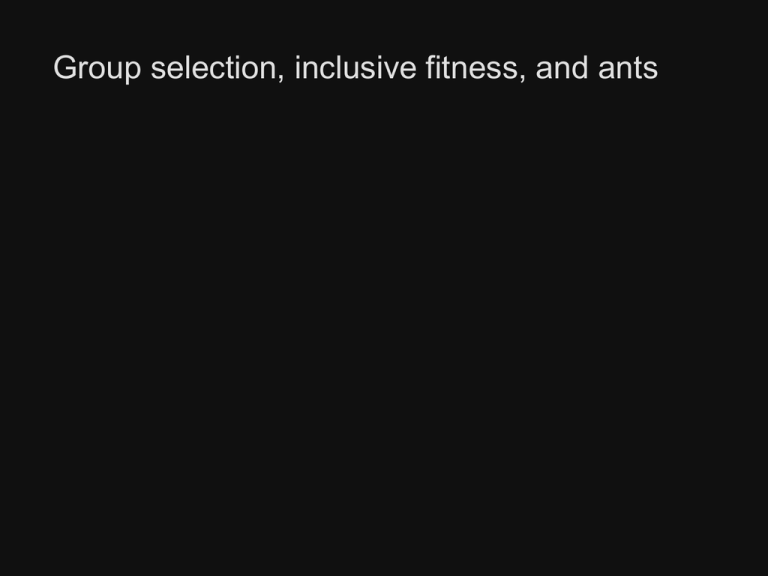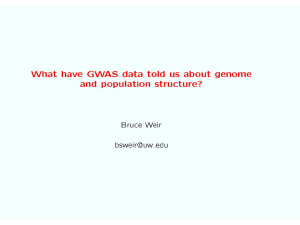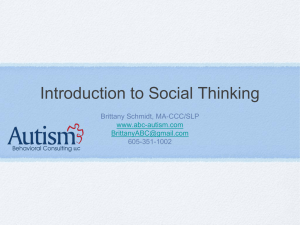
Group selection, inclusive fitness, and ants
ants (Hymenoptera: Formicidae)
• 10-12,000 species; 15-25% of animal biomass worldwide
• all are eusocial colonies of fertile queens & sterile workers, 3
classes of offspring:
• gynes
• workers
• males
• how is eusociality produced
and maintained?
ants (Hymenoptera: Formicidae)
• 10-12,000 species; 15-25% of animal biomass worldwide
• all are eusocial colonies of fertile queens & sterile workers, 3
classes of offspring:
• gynes
• workers
• males
• how is eusociality produced
and maintained?
ants (Hymenoptera: Formicidae)
• 10-12,000 species; 15-25% of animal biomass worldwide
• all are eusocial colonies of fertile queens & sterile workers, 3
classes of offspring:
• gynes
• workers
• males
• how is eusociality produced
and maintained?
inclusive fitness, kin selection
• W.D. Hamilton (1964, 1972), then Trivers & Hare (1976), then
Boomsma & Grafen (1990, 1991)
• fitness = direct reproduction + effects on others’ reproduction
• aiding in reproduction of others is favored if:
fitness benefit to relative x relatedness > fitness cost to self
inclusive fitness, kin selection
• W.D. Hamilton (1964, 1972), then Trivers & Hare (1976), then
Boomsma & Grafen (1990, 1991)
• fitness = direct reproduction + effects on others’ reproduction
• aiding in reproduction of others is favored if:
fitness benefit to relative x relatedness > fitness cost to self
inclusive fitness, kin selection
• W.D. Hamilton (1964, 1972), then Trivers & Hare (1976), then
Boomsma & Grafen (1990, 1991)
• fitness = direct reproduction + effects on others’ reproduction
• aiding in reproduction of others is favored if:
fitness benefit to relative x relatedness > fitness cost to self
ants: haplodiploidy
haplodiploidy
• due to haplodiploid reproduction, ant workers may be more closely
related to a queen’s offspring than to their own
• this supports the evolution of eusociality
• however, conditions for rqueen’s offspring > rown offspring are limited, and
origins of eusociality aren’t tractable
haplodiploidy
• due to haplodiploid reproduction, ant workers may be more closely
related to a queen’s offspring than to their own
• this supports the evolution of eusociality
• however, conditions for rqueen’s offspring > rown offspring are limited, and
origins of eusociality aren’t tractable
haplodiploidy
• due to haplodiploid reproduction, ant workers may be more closely
related to a queen’s offspring than to their own
• this supports the evolution of eusociality
• however, conditions for rqueen’s offspring > rown offspring are limited
• origins of eusociality aren’t tractable
haplodiploidy
• monogynous colonies & singly mated queens & 1:1 sex investment
ratios relatedness of workers to queen’s offspring = 0.5
• if sex investment ratio = relatedness skew (1:3 males:females)
r = 0.625
• 1:3 sex investment ratio
is generally found in these
conditions
haplodiploidy
• monogynous colonies & singly mated queens & 1:1 sex investment
ratios relatedness of workers to queen’s offspring = 0.5
• if sex investment ratio = relatedness skew (1:3 males:females)
r = 0.625
• 1:3 sex investment ratio
is generally found in these
conditions
haplodiploidy
• monogynous colonies & singly mated queens & 1:1 sex investment
ratios relatedness of workers to queen’s offspring = 0.5
• if sex investment ratio = relatedness skew (1:3 males:females)
r = 0.625
• 1:3 sex investment ratio
is generally found in these
conditions
problems
• polygynous colonies?
• multiple mating of queens?
• < relatedness of workers to the queen’s offspring
• but if you can’t explain eusociality, at least explain sex ratios...
problems
• polygynous colonies?
• multiple mating of queens?
• < relatedness of workers to the queen’s offspring
• but if you can’t explain eusociality, at least explain sex ratios...
problems
• polygynous colonies?
• multiple mating of queens?
• < relatedness of workers to the queen’s offspring
• but if you can’t explain eusociality, at least explain sex ratios...
multiple mating
• multiple mating overall relatedness drops; but relatedness to male
offspring is unchanged
• more male-biased sex investment ratio
multiple mating
• multiple mating overall relatedness drops; but relatedness to male
offspring is unchanged
• more male-biased sex investment ratio
multiple mating
• effective mating frequency is generally low in ants
• facultatively polyandrous ants:
predicted changes occur (Leptothorax) or not (Lasius)
• obligate polyandry (rare):
predicted changes occur (Attini) or not (Pogonomyrmex)
multiple mating
• effective mating frequency is generally low in ants
• facultatively polyandrous ants:
predicted changes occur (Leptothorax) or not (Lasius)
• obligate polyandry (rare):
predicted changes occur (Attini) or not (Pogonomyrmex)
multiple mating
• effective mating frequency is generally low in ants
• facultatively polyandrous ants:
predicted changes occur (Leptothorax) or not (Lasius)
• obligate polyandry (rare):
predicted changes occur (Attini) or not (Pogonomyrmex)
polygyny
• polygyny relatedness drops
• related queens relatedness asymmetry changes
• unrelated queens relatedness asymmetry unchanged
• polygyny greater cost of gynes?
polygyny
• polygyny relatedness drops
• related queens relatedness asymmetry changes
• unrelated queens relatedness asymmetry unchanged
• polygyny greater cost of gynes?
polygyny
• polygyny relatedness drops
• related queens relatedness asymmetry changes
• unrelated queens relatedness asymmetry unchanged
• polygyny greater cost of gynes?
polygyny
• gynes cost more more male-biased sex ratio (or investment ratio)
• related queens more male-biased sex investment ratio
• support mixed; polygyne ants generally more male-biased, but:
• competitive benefit from neighboring related nests (Linepithema)
• polygyny shifts sex investment ratios without relatedness
asymmetry changes (e.g. Pheidole, Formica)
polygyny
• gynes cost more more male-biased sex ratio (or investment ratio)
• related queens more male-biased sex investment ratio
• support mixed; polygyne ants generally more male-biased, but:
• competitive benefit from neighboring related nests (Linepithema)
• polygyny shifts sex investment ratios without relatedness
asymmetry changes (e.g. Pheidole, Formica)
polygyny
• gynes cost more more male-biased sex ratio (or investment ratio)
• related queens more male-biased sex investment ratio
• support mixed; polygyne ants generally more male-biased, but:
• competitive benefit from neighboring related nests (Linepithema)
• polygyny shifts sex investment ratios without relatedness
asymmetry changes (e.g. Pheidole, Formica)
split sex ratios
• colonies often specialize in production of one sex
• Boomsma & Grafen (1990, 1991) colonies specialize in sex to
which workers are more related than average
• supporting evidence in some taxa, but:
• split sex ratios without any relatedness changes (Solenopsis)
• or in the opposite direction (e.g., Pheidole)
split sex ratios
• colonies often specialize in production of one sex
• Boomsma & Grafen (1990, 1991) colonies specialize in sex to
which workers are more related than average
• supporting evidence in some taxa, but:
• split sex ratios without any relatedness changes (Solenopsis)
• or in the opposite direction (e.g., Pheidole)
split sex ratios
• colonies often specialize in production of one sex
• Boomsma & Grafen (1990, 1991) colonies specialize in sex to
which workers are more related than average
• supporting evidence in some taxa, but:
• split sex ratios without any relatedness changes (Solenopsis)
• or in the opposite direction (e.g., Pheidole)
nepotism?
• polyandry and polygyny selection for nepotism in workers
• nepotism is rare or absent!
nepotism?
• polyandry and polygyny selection for nepotism in workers
• nepotism is rare or absent!
males?
• males generally ignored in inclusive fitness explanations
• male fitness increases with female-biased investment
• if sex-ratio arguments are correct strong selection in males
against multiple mating
males?
• males generally ignored in inclusive fitness explanations
• male fitness increases with female-biased investment
• if sex-ratio arguments are correct strong selection in males
against multiple mating
males?
• males generally ignored in inclusive fitness explanations
• male fitness increases with female-biased investment
• if sex-ratio arguments are correct strong selection in males
against multiple mating
phylogenetic inertia?
• can this explain tolerance of polygyny?
• workers may be stuck with sociality, but they are not stuck with
polygyny, or even queens:
• queen-killing occurs (Linepithema), but not nepotistically!
• reproduction can (rarely) be coopted by workers (Rhytidoponera)
phylogenetic inertia?
• can this explain tolerance of polygyny?
• workers may be stuck with sociality, but they are not stuck with
polygyny, or even queens:
• queen-killing occurs (Linepithema), but not nepotistically!
• reproduction can (rarely) be coopted by workers (Rhytidoponera)
so what’s the alternative?
• reviews of kin selection in Hymenoptera omit competing
hypotheses!
• what about group selection?
so what’s the alternative?
• reviews of kin selection in Hymenoptera omit competing
hypotheses!
• what about group selection?
group selection
• formed by analogy to natural selection:
“This preservation of favourable variations and the rejection of
injurious variations, I call Natural Selection.” Darwin, 1859.
• Darwin does not specify the units of selection here
group selection
• formed by analogy to natural selection:
“This preservation of favourable variations and the rejection of
injurious variations, I call Natural Selection.” Darwin, 1859.
• Darwin does not specify the units of selection here
group selection
• the between-group component of natural selection
• preconditions: heritable variation in fitness between groups
• this is probably a general property:
• random sampling error
• assortative group membership
group selection
• the between-group component of natural selection
• preconditions: heritable variation in fitness between groups
• this is probably a general property:
• random sampling error
• assortative group membership
group selection
• the between-group component of natural selection
• preconditions: heritable variation in fitness between groups
• this is probably a general property:
• random sampling error
• assortative group membership
group selection
• increased recent prominence; E.O. Wilson has announced the
demise of kin selection
• need not be in conflict with individual-level selection
• increases with partitioning of variance between vs. within groups
group selection
• increased recent prominence; E.O. Wilson has announced the
demise of kin selection
• need not be in conflict with individual-level selection
• increases with partitioning of variance between vs. within groups
group selection
• increased recent prominence; E.O. Wilson has announced the
demise of kin selection
• need not be in conflict with individual-level selection
• increases with partitioning of variance between vs. within groups
what are groups?
• all units are groups at a lower level of analysis
• the question is: which is most explanatory?
• genes of ultimate importance, but selected through phenotype:
• which level of phenotype?
• primary unit of selection reproduction?
• colonies reproduce
what are groups?
• all units are groups at a lower level of analysis
• the question is: which is most explanatory?
• genes of ultimate importance, but selected through phenotype:
• which level of phenotype?
• primary unit of selection reproduction?
• colonies reproduce
what are groups?
• all units are groups at a lower level of analysis
• the question is: which is most explanatory?
• genes of ultimate importance, but selected through phenotype:
• which level of phenotype?
• primary unit of selection reproduction?
• colonies reproduce
what are groups?
• all units are groups at a lower level of analysis
• the question is: which is most explanatory?
• genes of ultimate importance, but selected through phenotype:
• which level of phenotype?
• primary unit of selection reproduction?
• colonies reproduce
group selection vs. kin selection
• within-group relatedness increases between-group partitioning of
variance
• the two are compatible explanations, not strict alternatives
• but predictions & explanatory value differ
group selection vs. kin selection
• within-group relatedness increases between-group partitioning of
variance
• the two are compatible explanations, not strict alternatives
• but predictions & explanatory value differ
group selection vs. kin selection
• within-group relatedness increases between-group partitioning of
variance
• the two are compatible explanations, not strict alternatives
• but predictions & explanatory value differ
is relatedness the right metric?
• Solenopsis invicta, Linepithema humile, other major invasives
characterized by unicoloniality:
• low or absent between-nest aggression, often across large areas
• relatedness in nests approaches 0
is relatedness the right metric?
• Linepithema humile:
• although relatedness is ~0, genetic similarity is high
• low relatedness may be a measurement artifact
•Solenopsis invicta:
• between-nest & between-queen cooperation determined by Gp-9
• single-locus identity, and not relatedness, controls social form
is relatedness the right metric?
• Linepithema humile:
• although relatedness is ~0, genetic similarity is high
• low relatedness may be a measurement artifact
•Solenopsis invicta:
• between-nest & between-queen cooperation determined by Gp-9
• single-locus identity, and not relatedness, controls social form
do colony characteristics determine success?
• Linepithema & Solenopsis:
• increased colony size large competitive advantage
• Formica:
• increased colony size exploitation of concentrated, long-term
resources
• Pogonomyrmex: decreased relatedness increased colony growth
do colony characteristics determine success?
• Linepithema & Solenopsis:
• increased colony size large competitive advantage
• Formica:
• increased colony size exploitation of concentrated, long-term
resources
• Pogonomyrmex: decreased relatedness increased colony growth
do colony characteristics determine success?
• Linepithema & Solenopsis:
• increased colony size large competitive advantage
• Formica:
• increased colony size exploitation of concentrated, long-term
resources
• Pogonomyrmex: decreased relatedness increased colony growth
explaining inclusive fitness gaps?
• absence of nepotism, tolerance of polygyny & low relatedness
more efficient colony function, better colony-level performance
• split sex ratios may be determined by colony-level factors:
• resource limitation
• local mate competition
• habitat saturation
explaining inclusive fitness gaps?
• absence of nepotism, tolerance of polygyny & low relatedness
more efficient colony function, better colony-level performance
• split sex ratios may be determined by colony-level factors:
• resource limitation
• local mate competition
• habitat saturation
but: the forgotten variables
• cost & benefit terms of Hamilton’s rule generally ignored
• can we accomodate everything by hiding it in those variables?
• yes, you can!
• but there is no explanatory or predictive value
• and it obscures explanatory integration
but: the forgotten variables
• cost & benefit terms of Hamilton’s rule generally ignored
• can we accomodate everything by hiding it in those variables?
• yes, you can!
• but there is no explanatory or predictive value
• and it obscures explanatory integration
but: the forgotten variables
• cost & benefit terms of Hamilton’s rule generally ignored
• can we accomodate everything by hiding it in those variables?
• yes, you can!
• but there is no explanatory or predictive value
• and it obscures explanatory integration
integration
• Pogonomyrmex genetic variation & productivity:
• is this analogous to heterozygote advantages?
• split sex ratios:
• aren’t we looking at evolution of gonochorism, one level up?
• do we want to reinvent the wheel for group-level explanations?
integration
• Pogonomyrmex genetic variation & productivity:
• is this analogous to heterozygote advantages?
• split sex ratios:
• aren’t we looking at evolution of gonochorism, one level up?
• do we want to reinvent the wheel for group-level explanations?
integration
• Pogonomyrmex genetic variation & productivity:
• is this analogous to heterozygote advantages?
• split sex ratios:
• aren’t we looking at evolution of gonochorism, one level up?
• do we want to reinvent the wheel for group-level explanations?
conclusions
• origins of eusociality not tractable in ants
• kin selection predictions for sex ratio hold for monogyny +
monandry, fail in other cases
• kin selection explanations neglect male fitness; predict nepotism;
rely on constraints
conclusions
• origins of eusociality not tractable in ants
• kin selection predictions for sex ratio hold for monogyny +
monandry, fail in other cases
• kin selection explanations neglect male fitness; predict nepotism;
rely on constraints
conclusions
• origins of eusociality not tractable in ants
• kin selection predictions for sex ratio hold for monogyny +
monandry, fail in other cases
• kin selection explanations neglect male fitness; predict nepotism;
rely on constraints
conclusions
• group selection (or multilevel selection) includes kin selection
explanations
• accounts for variance independent of relatedness
• aids explanation of colony functionality, fosters integration of
theory across levels
conclusions
• group selection (or multilevel selection) includes kin selection
explanations
• accounts for variance independent of relatedness
• aids explanation of colony functionality, fosters integration of
theory across levels
conclusions
• group selection (or multilevel selection) includes kin selection
explanations
• accounts for variance independent of relatedness
• aids explanation of colony functionality, fosters integration of
theory across levels







